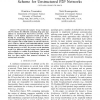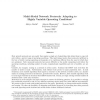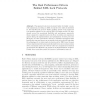140 search results - page 12 / 28 » Self-stabilizing population protocols |
IROS
2006
IEEE
14 years 3 months ago
2006
IEEE
— Inter-robot communication is essential if general purpose intelligent decentralized multiple-robot systems are to become a reality. Traditionally, explicit communication amongs...
EUROPAR
2005
Springer
14 years 3 months ago
2005
Springer
— We present the Adaptive Group Notification (AGNO) scheme for efficiently contacting large peer populations in unstructured Peer-to-Peer networks. AGNO defines a novel implic...
SFM
2011
Springer
13 years 19 days ago
2011
Springer
The heterogeneity characterizing the systems populating the Ubiquitous Computing environment prevents their seamless interoperability. Heterogeneous protocols may be willing to coo...
CCR
2002
13 years 9 months ago
2002
Most network protocols are uni-modal: they employ a single set of algorithms that allows them to cope well only within a narrow range of operating conditions. This rigid design re...
DEXA
2009
Springer
14 years 4 months ago
2009
Springer
Abstract. Fine-grained lock protocols should allow for highly concurrent transaction processing on XML document trees, which is addressed by the taDOM lock protocol family enabling...



